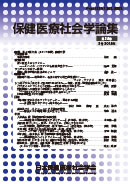Volume 28, Issue 2
Displaying 1-16 of 16 articles from this issue
- |<
- <
- 1
- >
- >|
Presidential Address
-
2018Volume 28Issue 2 Pages 1-10
Published: January 31, 2018
Released on J-STAGE: February 26, 2019
Download PDF (685K)
Educational Lecture
-
2018Volume 28Issue 2 Pages 11-19
Published: January 31, 2018
Released on J-STAGE: February 26, 2019
Download PDF (537K)
Luncheon Seminar
-
2018Volume 28Issue 2 Pages 20-24
Published: January 31, 2018
Released on J-STAGE: February 26, 2019
Download PDF (317K)
Special Lecture
-
2018Volume 28Issue 2 Pages 25-35
Published: January 31, 2018
Released on J-STAGE: February 26, 2019
Download PDF (525K)
Symposium
-
2018Volume 28Issue 2 Pages 36-43
Published: January 31, 2018
Released on J-STAGE: February 26, 2019
Download PDF (496K) -
2018Volume 28Issue 2 Pages 44-53
Published: January 31, 2018
Released on J-STAGE: February 26, 2019
Download PDF (709K) -
2018Volume 28Issue 2 Pages 54-64
Published: January 31, 2018
Released on J-STAGE: February 26, 2019
Download PDF (548K)
Original Articles
-
2018Volume 28Issue 2 Pages 65-75
Published: January 31, 2018
Released on J-STAGE: February 26, 2019
Download PDF (479K) -
2018Volume 28Issue 2 Pages 76-86
Published: January 31, 2018
Released on J-STAGE: February 26, 2019
Download PDF (532K)
Book Reviews
-
2018Volume 28Issue 2 Pages 87-88
Published: January 31, 2018
Released on J-STAGE: February 26, 2019
Download PDF (256K) -
2018Volume 28Issue 2 Pages 89-90
Published: January 31, 2018
Released on J-STAGE: February 26, 2019
Download PDF (252K) -
2018Volume 28Issue 2 Pages 91-92
Published: January 31, 2018
Released on J-STAGE: February 26, 2019
Download PDF (270K) -
2018Volume 28Issue 2 Pages 93-94
Published: January 31, 2018
Released on J-STAGE: February 26, 2019
Download PDF (326K) -
2018Volume 28Issue 2 Pages 95-96
Published: January 31, 2018
Released on J-STAGE: February 26, 2019
Download PDF (266K) -
2018Volume 28Issue 2 Pages 97-98
Published: January 31, 2018
Released on J-STAGE: February 26, 2019
Download PDF (238K)
-
2018Volume 28Issue 2 Pages 99
Published: January 31, 2018
Released on J-STAGE: February 26, 2019
Download PDF (168K)
- |<
- <
- 1
- >
- >|
